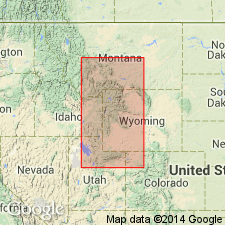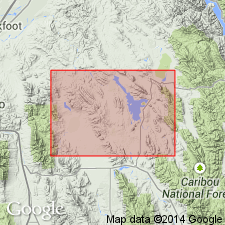
- Usage in publication:
-
- Meade Peak phosphatic shale member*
- Modifications:
-
- Named
- Dominant lithology:
-
- Shale
- Phosphorite
- AAPG geologic province:
-
- Wasatch uplift
Summary:
Named by McKelvey (p. 22-5) as member of Phosphoria formation for Meade Peak, highest point on Snowdrift Mtn, about 2 1/2 mi south of Phosphoria Gulch. Type area is measured section in bulldozer trench in NW1/4 NW1/4 sec 8, T10S, R45E Bear Lake Co, ID on Wasatch uplift. Is recognized in northern UT (Uinta basin, Uinta uplift), southeast ID(Snake River and Greater Green River basins), central and western MT (Montana folded belt province), and western WY (Wind River and Greater Green River basins). Is composed mainly of dark-gray, argillaceous carbonate rock, medium-hard, thin-bedded brownish-black phosphorite, and grayish-brown phosphatic mudstone, 199.9 ft thick at type. Dark carbonate rock takes place of mudstone and phosphorite southward toward UT. Eastward upper and lower parts of member change to chert and carbonate and middle sandy phosphorite extends eastward as a tongue. Pelletal phosphorite is abundant at type. Oolitic, pisolitic and bioclastic phosphorite are abundant on fringe areas. Ranges from 125 to 225 ft thick in southeast ID and thins westward in ID. Upper and lower contacts defined as base and top of dark carbonaceous or phosphatic beds. Throughout southeast ID lowest bed contains abundant fish scales, bones, and nodules. Overlies Grandeur tongue of Park City formation; underlies Rex chert member of Phosphoria. Is shallow, water marine deposit of Permian age. Contains brachiopods, cephalopods, and conodonts.
Source: GNU records (USGS DDS-6; Denver GNULEX).

- Usage in publication:
-
- Meade Peak Phosphatic Shale Member*
- Modifications:
-
- Age modified
- Biostratigraphic dating
- AAPG geologic province:
-
- Snake River basin
- Wasatch uplift
Summary:
Is lower member of Phosphoria Formation in Caribou Co (Wasatch uplift) and Bingham Co (Snake River basin), southeastern ID. Overlies Grandeur Member of Park City Formation; underlies Rex Chert Member of Phosphoria. Age changed to Leonardian and Guadalupian (Roadian and Wordian) on basis of conodont biostratigraphy; North American series boundary placed within upper part of Meade Peak. Three conodont zones are recognized in the Meade Peak Member and sub- and superjacent units. NEOSTREPTOGNATHODUS SULCOPLICATUS Zone (Roadian) identified in Grandeur Member and lowermost part of Meade Peak. NEOGONDOLELLA GRACILIS-N. SERRATA Zone (late Roadian) occurs entirely in Mead Peak. N. PHOSPHORIENSIS Zone (early Wordian) found in uppermost Meade Peak and most of Rex Chert Member. Zonal transition of N. GRACILIS-N. SERRATA to N. PHOSPHORIENSIS is correlated with currently accepted Leonardian-Guadalupian series boundary (Roadian-Wordian stage boundary) of the Early Permian.
Source: GNU records (USGS DDS-6; Denver GNULEX).
For more information, please contact Nancy Stamm, Geologic Names Committee Secretary.
Asterisk (*) indicates published by U.S. Geological Survey authors.
"No current usage" (†) implies that a name has been abandoned or has fallen into disuse. Former usage and, if known, replacement name given in parentheses ( ).
Slash (/) indicates name conflicts with nomenclatural guidelines (CSN, 1933; ACSN, 1961, 1970; NACSN, 1983, 2005, 2021). May be explained within brackets ([ ]).

